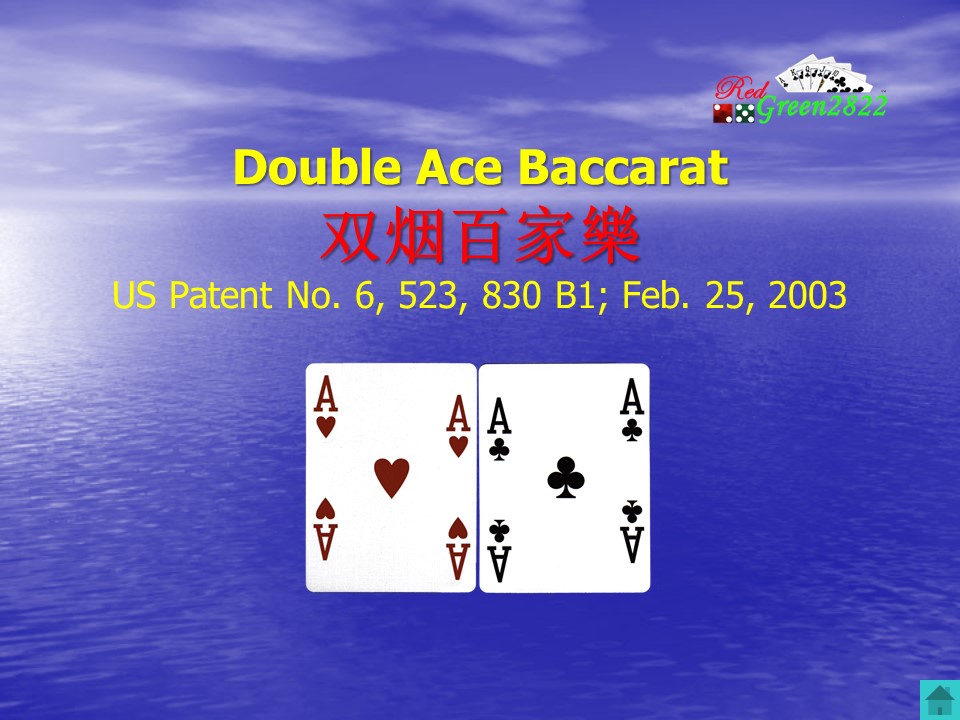Double Ace Baccarat
双烟百家樂
Table Sign
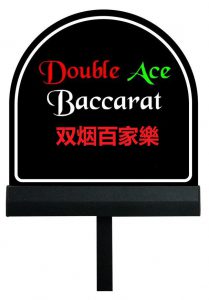
Major Layout
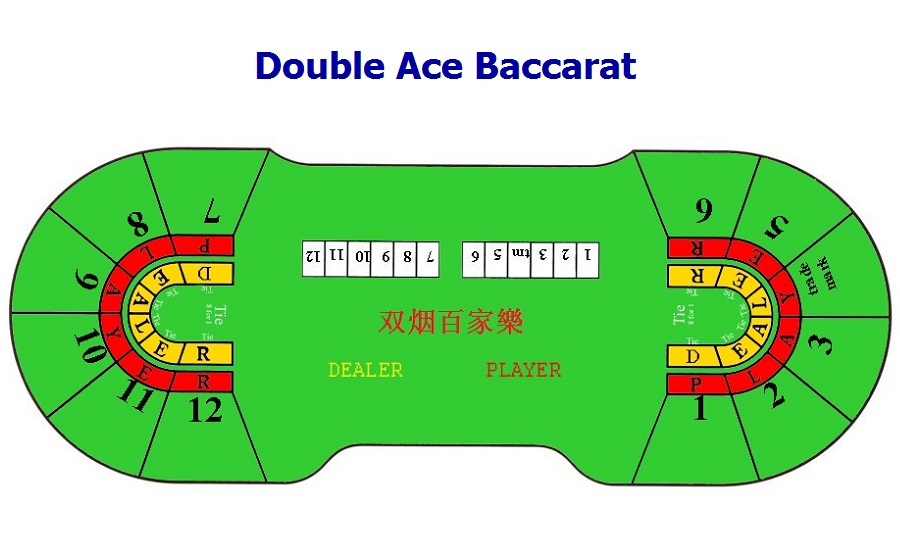
Mini Layout
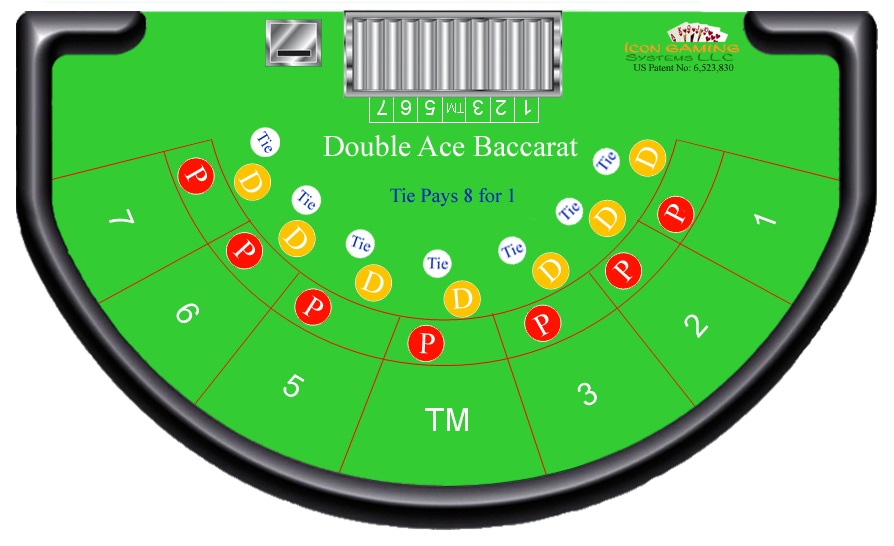
RANKING
- First high: AA (Natural Double Ace)
- Second high: Ace and 10 = 10
- Third high: 10
- Descending order: 9, 8, 7, 6, 5, 4, and 3.
BUSTING HAND
- Hand close to 10 then the other is a winner.
- For example: Busting hand 11 wins over busting hand 12
PLAYING RULES
- Game plays with 8 decks, all face cards (J, Q, and K) are removed. Game deals 2 hands, a Dealer hand and a Player hand, both hands are allowed one draw. The Player hand draws first then the Dealer hand. The Dealer hand draws or stands depending on the Player hand (same as Standard Baccarat), with drawing exceptions (see the Drawing Exceptions)
- A non-busted hand always wins over the busted hand.
- Objective is to reach a sum closest to 10 without exceeding 10. If either Player hand or Dealer hand receives a total of 11 or higher, the hand is considered a busting hand.
- Both the Player hand and the Dealer hand have to draw one card only on 5 or lower and stand on 6 or higher.
- If both the Player hand and the Dealer hand bust, then the hand closest to 10 is the winner.
- An Ace is a wild Card, it can either be 0 or 1.
Drawing Exceptions
- Natural Double Aces (A + A) is higher than Natural 10 (10 + Ace = 10). If the Player hand has an Ace and draws another Ace (Natural Double Aces) and:
- the Dealer hand has no Ace, then Dealer cannot draw.
- the Dealer hand has an Ace, then the Dealer can draw.
- If the Player hand has an Ace and draws a 10 = (Natural 10) and:
- the Dealer hand has no Ace, then Dealer cannot draw.
- the Dealer hand has an Ace, then the Dealer can draw.
- If the Player hand has an Ace and draws a 2 through 9 and:
- the Dealer hand is a 5 or lower, then the Dealer has to draw.
- the Dealer hand is a 6 or higher, then the Dealer stands.
- If the Player hand draws a card and caused it busts with a total of 11, and
- the Dealer hand is a 5 or lower, then the Dealer draws.
- the Dealer hand is a 6 or higher, then the Dealer stands.
- If the Player hand draws a card and caused it busts with a total of 12 or higher, then Dealer stands.
Pay Out
If the Player hand wins, pay even money.
If the Dealer hand wins, pay even money less than 5% commission.
If it’s a tie, pay 7 to 1 (8 for 1).
ANALYSIS
Rules of Play
Double Ace Baccarat is a variation of Baccarat. It is played with eight standard decks of cards with all face cards removed. So, there are 8 x 40 = 320 cards to use. The player can make any combination of three bets before any cards are dealt: the Player hand bet, the Dealer hand bet and the Tie bet.
The objective of the game is for the player to successfully wager on whether the Dealer hand or the Player hand will win.
Each player makes a wager on whether the Dealer hand or the Player hand will win. Players may place an optional Tie bet and win 7 to 1 if the Dealer hand and Player hand tie. After all wagers are made, one card each is dealt face up to the Player’s position and the Dealer’s position on the table layout. Aces count 1, and 2s through 10s count their face value. When a hand contains two cards, the sum of the two cards is its score. The highest score is 10 (e.g., 10, 7 + 3, A + 9), and the lowest score is 3 (A + 2). If the sum exceeds 10, then the hand is said to “bust.” However, two Aces (Natural Double Aces) are the highest ranked hand, and one Ace and one 10 (Ace-10) are the second highest hand which outranks a score of 10 points.
If the first card dealt to a hand is 6 or higher, that hand must stand. If the first card dealt is 5 or lower, that hand is allowed to draw one and only one card. The Player hand draws first. The Dealer hand will stand or draw depending on the Player hand. There are some exceptions to the draw rules as will be explained below:
- When the first card of the Player hand is Ace:
- If the Player’s second card is also Ace, the Dealer hand must stand if the Dealer’s first card is not Ace. If the Dealer’s first card is Ace, it draws a card.
- If the Player’s second card is 10 (hence, Ace-10), the Dealer hand must stand if the Dealer’s first card is not Ace. If the Dealer’s first card is Ace, it draws a card.
- If the Player’s second card is neither Ace nor 10, the Dealer hand should draw a card if the Dealer’s first card is below 6 and also less than the Player hand score.
- When the first card of the Player hand is not Ace:
- The Player hand must draw if the first card is below 6; otherwise it must stand.
- The Dealer hand must stand if (i) its first card is 6 or higher, or (ii) the Player hand has busted with a score of 12 or greater. Otherwise, the Dealer hand has to draw if its first card is below 6.
After the house dealer has played out the two hands, the final score of each hand will be announced and the two scores are compared to determine the winner. Whoever has the higher score wins. A winning Dealer hand has to pay a 5% commission. A busted hand would lose to any non-busted hand. When both Player and Dealer hands busted, the hand with a final score closer to 10 points wins. For example, if the Player hand had 11 and the Dealer hand had 13, then the Player hand would win. A tie is a push. Those who bet Tie would win 7 to 1.
Mathematical Analysis
A combinatorial analysis was performed to derive the probability distribution and the house advantages. Due to some of the rules in favor of the Dealer hand, the Dealer hand would win more often, thereby deriving an edge over the Player hand. However, as the Dealer hand has to pay the commission, the house gains back the edge over the Dealer hand. The probability distribution is shown below:
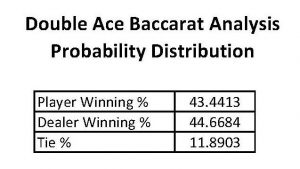
Based on the above probability distribution, the house advantage on the Player hand is 44.6684% – 43.4413% = 1.227%. The house advantage on the Dealer hand is 43.4413% – 44.6684% x (100% – 5%) = 1.0064%.
The house advantage on the Tie bet can be computer as follows:
100% – 11.8903% x (7 + 1) = 4.8774%.
A computer simulation of 200 million hands was run to verify the accuracy of the analysis.
Presented By: Stanley Ko
BetWiser Games, LLC – PO Box 82225 – Las Vegas, NV 89180 – (702) 258-9685
May 4, 2010
Standard Baccarat’s Analysis – House’s Advantage
The house edge on the possible outcomes of the banker, player, and tie bets for an 8-deck game:
Banker bet is 1.06%
Player bet is 1.24%
Tie bet is 14.36%
Double Ace Baccarat’s Analysis – House’s Advantage
The house advantage on the possible outcomes of the Dealer, player and tie bets for an 8-deck game:
Dealer hand is 43.4413% – 44.6684% x (100% – 5%) = 1.0064%
Player hand is 44.6684% – 43.4413% = 1.227%.
Tie bet is 100% – 11.8903% x (7 + 1) = 4.8774%.
The Double Ace Baccarat house advantage is close to the Standard Baccarat.
